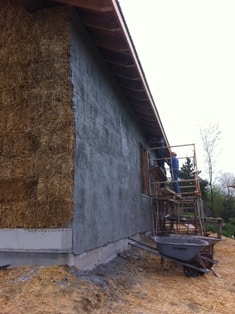Over the years through conversations and books I have heard that it is fine to plaster directly onto straw bales without the use of any type of mesh reinforcement as long as the mix is lime or earth based. I recently did somewhat of a test on this by plastering a house that had both: bales covered with welded wire mesh and bales left without mesh. I know I will catch some flack for this, but to those of us involved in the “test” the answer was clear. Plastering bale walls that are covered with welded wire mesh is way better than an unmeshed wall.

I can’t change your mind on those things (perhaps), but I can at least point out that a house built to last is more environmentally friendly, safer, and more economical than one built on the cheap.
I’ve listed the biggest problems with plastering directly on the bales here.
- Here’s mud in your eye! When plastering on walls that have no mesh, the straw is likely to flick the plaster back at you as you apply it to the wall. Not a big deal if it is “mud” in your eye, but it is more of a big deal if you are using lime plaster (which in my mind is almost always the best choice) as lime can and will burn your eyes. In fact, of all the warnings on bags of lime, the most prominent are those warning of direct eye contact. Yes, glass are a cheap fix to this problem, but it is something that is easily fixed by using mesh.
- Stuffing. It’s pretty common to need to stuff areas of a wall with loose straw between bales or against a post. Not everyone is perfect with a chainsaw or with measuring and retying a bale. As a result, loose stuffing is often used to pack those gaps. To begin with, it is very important that these gaps be filled with long straw and packed very tightly in place. In fact, a clay slip applied to the packing can be a good idea too. Even further, some folks choose to use cob in the gaps (if they are big enough to warrant doing so) but this brings up other issues with bonding between materials like cob and lime plaster. That’s for another blog post another day. Anyway, back to the stuffing. With no mesh to hold the looser material in place, it can fall out of the wall under the weight of the plaster. Obviously, not good.
- Loose straw doesn’t hold plaster. Just like the stuffing issue, the uncut edges of bales can be hard to plaster. In other words, if there is a part of the bale that has long straw hanging out of it, the plaster will stick to the straw and then potentially fall off the wall. It also tends to hold the straw away from the solid surface of the bale meaning that the connection between the plaster and the straw is connected to the loose ends only, not the main bale.
- Smooth bales are hard to plaster. On each bale, there are two edges: a cut edge and a folded edge. The folded edge can be very slick, depending on the type of straw used, and as such, it is hard to key the plaster into it. This means that even plaster that appears to be sticking well can ultimately fail if it is not well anchored to the bales.
- No reinforcement. Plaster without reinforcement, is not as good as plaster with reinforcement, it’s just a physical reality. Yes, the plaster can get that reinforcement from the bales if properly keyed in; however, as mentioned above, that keying is not as easy to accomplish without mesh. By adding mesh, you are adding tensile strength to the plaster. Like concrete, plaster is very strong under compressive loads (pushing it together) but weak under tensile stress (pulling it apart). The mesh give you extra strength in the tensile stress situations meaning less cracks and overall better plaster.
So I don’t suggest that everyone who says you can plaster directly on the bale is wrong. In fact, I agree that it can be done; however, I believe that it is not as good of an installation as can be accomplished with mesh. I prefer to shoot for the best installation possible. To me, that means mesh is best.
If you’re interested in really learning how to build with bales and you want to have perhaps one of the best weeks of your life in the process, then come to one of our workshops. We ALWAYS have a good time and you will gain the confidence to build your own house too. CLICK HERE to see what workshop locations and dates we have available this year!


